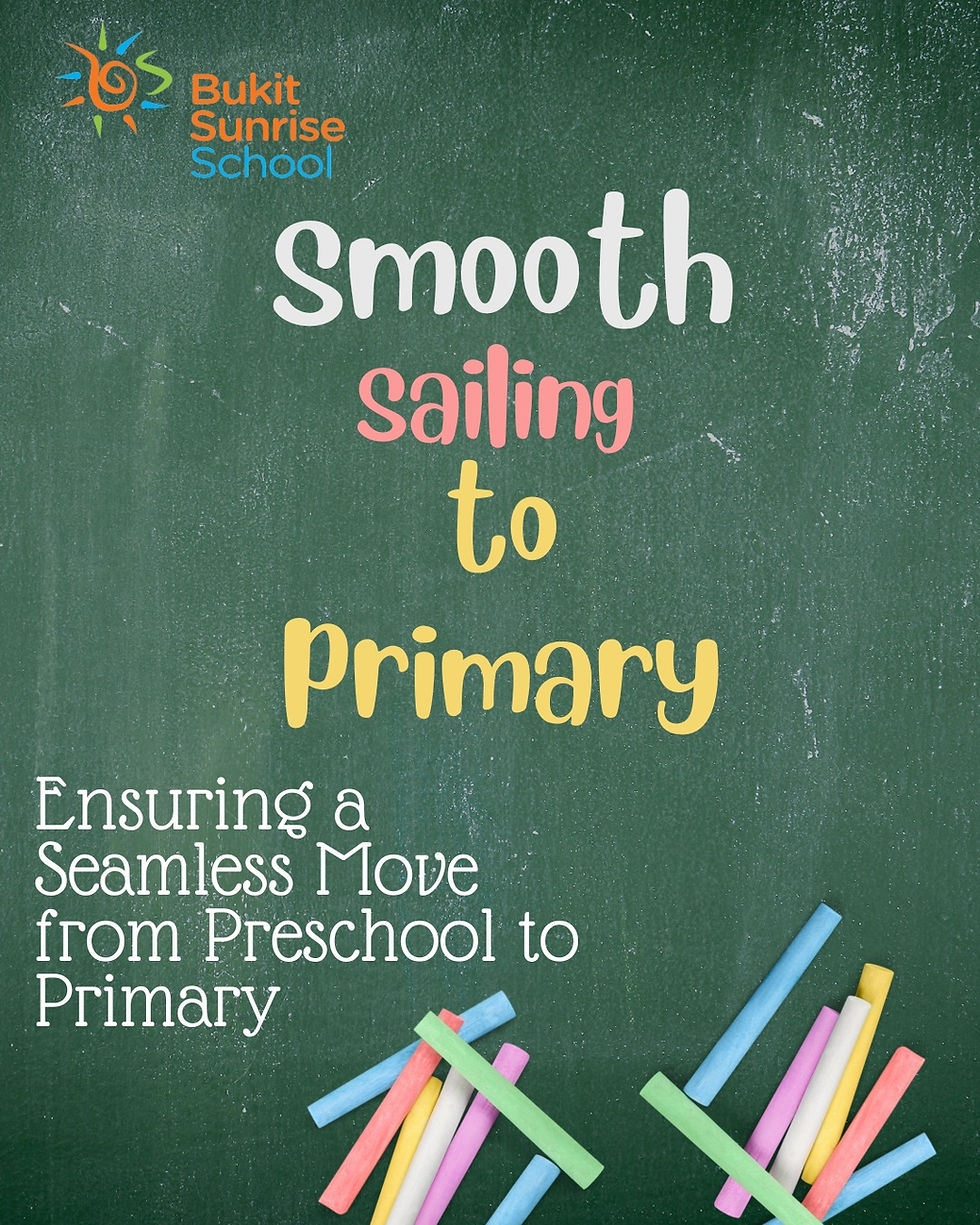Smooth Sailing to Primary: Ensuring a Seamless Move from Preschool to Primary
- Bukit Sunrise School
- Sep 12
- 3 min read

The transition from the nurturing environment of preschool to the structured world of primary school is a monumental step in a child's life. While it's an exciting milestone, it can also be a source of anxiety for both children and their parents. A smooth transition is crucial for a child's academic success and emotional well-being. By taking a proactive approach, parents and educators can work together to ensure this move is a seamless and positive experience.
Understanding the Shift
The jump to primary school involves significant changes. The learning environment shifts from play-based and child-led to a more formal, teacher-directed curriculum. Expectations for independence, following instructions and social interaction increase. Children are expected to manage their belongings, navigate a larger campus, and form new friendships in a bigger peer group. Understanding these changes is the first step toward preparing them.
Practical Steps for a Seamless Transition
Cultivate independence: Preschool is an ideal time to build foundational skills for self-sufficiency. Encourage your child to pack their own backpack, open their lunchbox and take care of their personal belongings. Simple tasks like putting on their shoes or zipping their jacket build confidence and reduce dependence on adults.
Foster a love for learning: While primary school focuses on academics, the love for learning begins much earlier. Engage your child with books, puzzles and educational games. Visit the library regularly and make reading a fun, daily ritual. This creates a positive association with learning that will serve them well in a formal school setting.
Familiarise them with the new environment: Whenever possible, visit the new school. Attend orientation days, school tours, or even just walk past the campus. Let your child see the playground, the classrooms, and the school hall. This reduces the fear of the unknown and makes the new school feel less intimidating.
Practice the new routine: Talk about the new school day—when they will wake up, when they will have lunch and when they will come home. Practice the school run a few times before the first day. A predictable routine provides comfort and security during a period of change.
Develop social skills: Primary school is a social hub. Arrange playdates with other children who will be in the same school or classroom. Encourage sharing, taking turns and communication. Role-playing scenarios, like asking for help from a teacher or introducing oneself to a new friend, can also be beneficial.
Maintain open communication with educators: Your child’s preschool teachers are an invaluable resource. They have a deep understanding of your child’s strengths and areas for development. Talk to them about your child’s readiness for primary school and ask for their advice. Similarly, once your child starts primary school, build a good relationship with their new teacher. A strong parent-teacher partnership is critical for a child’s success.
The Emotional Component
The emotional well-being of a child is paramount during this transition. It’s normal for children to feel anxious, excited, or even sad about leaving their preschool friends and teachers.
Acknowledge their feelings: Validate your child’s emotions. Say things like, "It's okay to feel a little bit nervous about the new school, but it's also so exciting to meet new friends!"
Share your positive outlook: Express your excitement and confidence in their ability to handle this new adventure. Your enthusiasm is contagious.
Keep communication open: Encourage your child to talk about their day. Listen to their stories, their triumphs, and their challenges. This shows them you are a safe and supportive listener.
Conclusion
A smooth transition from preschool to primary school is a shared responsibility. By preparing children emotionally and practically, and by fostering a collaborative relationship between parents and educators, we can transform this significant milestone into a period of growth and confidence. This preparation not only eases the move but also lays a strong foundation for a child's entire educational journey.
References:
U.S. Department of Education. "A Parent's Guide to School Readiness." Ready To Learn Initiative, 2005. This guide provides an overview of the skills and behaviors children need to be ready for school.
Giallo, R., Treyvaud, K., Rose, N., & Matthews, J. (2010). "Parental mental health and children’s school readiness." Journal of Applied Developmental Psychology, 31(2), 177-185. This research explores the role of parental well-being in a child's school readiness.
LoCasale-Crouch, J., Mashburn, A. J., Hamre, B. K., & Pianta, R. C. (2008). "The transition to kindergarten: A framework for research and practice." Educational Psychologist, 43(4), 224-239. This article offers a theoretical framework for understanding the transition process and suggests practical strategies for both parents and educators.
Pianta, R. C., Cox, M. J., & Snow, K. L. (Eds.). (2007). School readiness: The transition to kindergarten. Paul H. Brookes Publishing Co. This book is a comprehensive resource on the topic, covering a wide range of factors influencing a successful transition.
























Comments